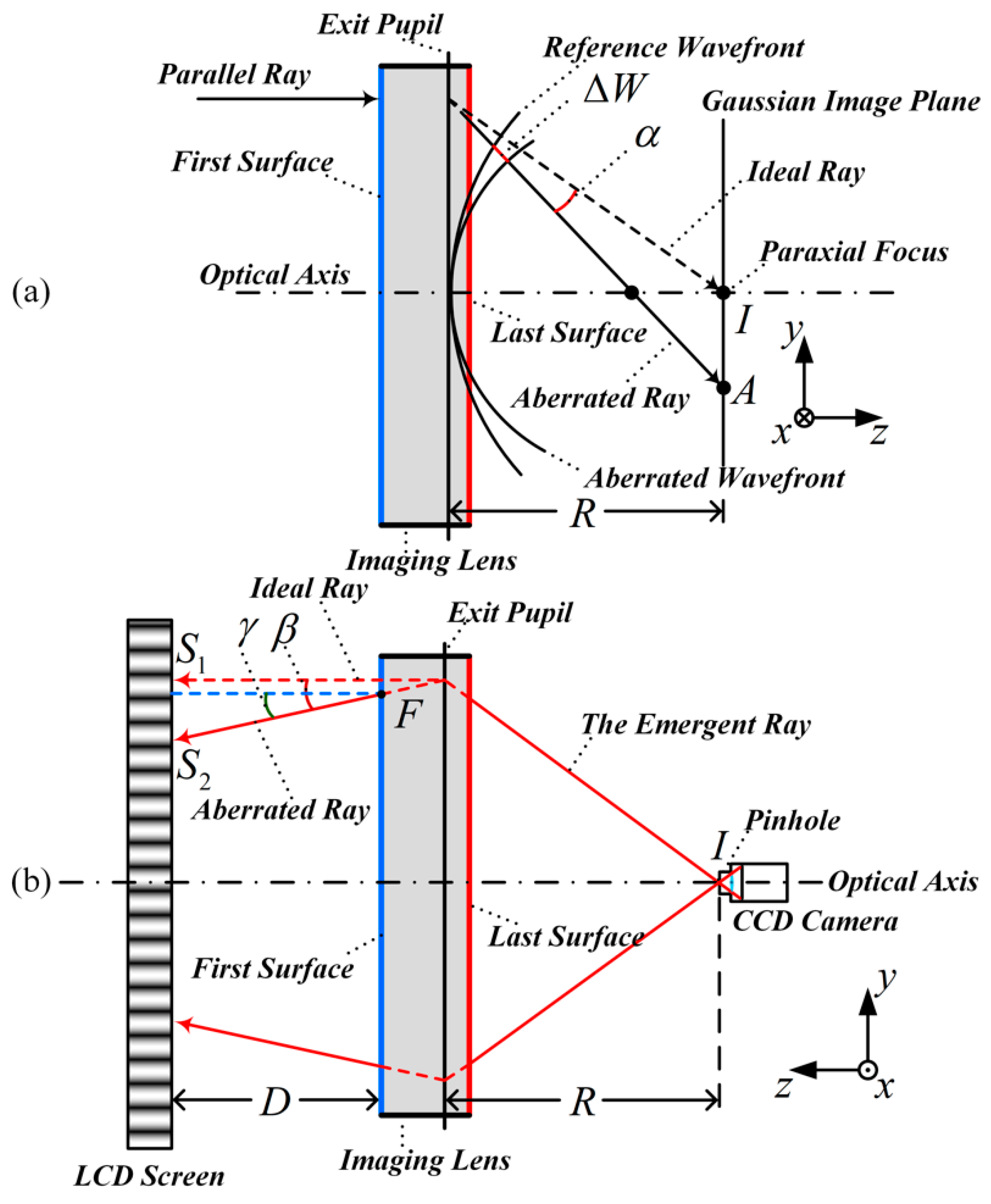Wavefront Aberration Measurement Deflectometry for Imaging Lens Tests
Abstract
:1. Introduction
2. Principles
3. Numerical Simulations
4. Experiment
5. Discussion
6. Conclusions
Author Contributions
Funding
Institutional Review Board Statement
Informed Consent Statement
Data Availability Statement
Conflicts of Interest
References
- Malacara, D. Optical Shop Testing, 3rd ed.; John Wiley & Sons: New York, NY, USA, 2007. [Google Scholar]
- Rodríguez, G.; Villa, J.; Martínez, G.; de la Rosa, I.; Ivanov, R. Towards the automatization of the Foucault knife-edge quantitative test. In Proceedings of the Third International Conference on Applications of Optics and Photonics, Faro, Portugal, 8–12 May 2017; SPIE: Bellingham, WA, USA, 2017; Volume 10453, pp. 431–438. [Google Scholar]
- Hernández-Delgado, J.; Malacara-Hernández, Z.; Malacara-Doblado, D.; Vázquez-Dorrío, B.; Malacara-Hernández, D. Local Curvatures and Its Measurements of an Optical Surface or a Wavefront: A Review. Opt. Eng. 2022, 61, 50901. [Google Scholar] [CrossRef]
- Aguirre-Aguirre, D.; Granados-Agustín, F.S.; Cornejo-Rodríguez, A. Obtaining the wavefront in the Ronchi test using only one Ronchigram with random coefficients of aberration. In Proceedings of the 22nd Congress of the International Commission for Optics: Light for the Development of the World, Puebla, Mexico, 15–19 August 2011; SPIE: Bellingham, WA, USA, 2011; Volume 8011, pp. 321–327. [Google Scholar]
- Li, P.; Tang, F.; Wang, X. Compensated Differential Zernike Fitting Method for Wavefront Aberration Metrology Based on Grating Lateral Shearing. Appl. Opt. 2022, 61, 1–9. [Google Scholar] [CrossRef] [PubMed]
- Twyman, F. An interferometer for testing camera lenses. Trans. Opt. Soc. 1921, 22, 174. [Google Scholar] [CrossRef]
- Weingaertner, I.; Schulz, M. Interferometric methods for the measurement of wavefront aberrations. In Specification and Measurement of Optical Systems; SPIE: Bellingham, WA, USA, 1993; Volume 1781, pp. 266–279. [Google Scholar]
- Chen, W.; Chen, L.; Zhang, X.; Zhang, Q. Geometrical Aberration Measurement by Experimental Ray-Tracing Based on Fiber Point Diffraction Interferometry. Meas. Sci. Technol. 2022, 33, 105004. [Google Scholar] [CrossRef]
- Neal, D.R.; Copland, J.; Neal, D.A. Shack-Hartmann wavefront sensor precision and accuracy. Proc. SPIE 2002, 4779, 148–160. [Google Scholar]
- Yu, J.; Fang, F.Z.; Qiu, Z.J. Aberrations measurement of freeform spectacle lenses based on Hartmann wavefront technology. Appl. Opt. 2015, 54, 986–994. [Google Scholar] [CrossRef]
- Markus, M.C.; Knauer, J.; Hausler, G. Phase measuring deflectometry: A new approach to measure specular free-form surfaces. SPIE Photonics Eur. 2004, 5457, 366–376. [Google Scholar]
- Huang, L.; Idir, M.; Zuo, C.; Asundi, A. Review of phase measuring deflectometry. Opt. Lasers Eng. 2018, 107, 247–257. [Google Scholar] [CrossRef]
- Canabal, H.; Alonso, J. Automatic wavefront measurement technique using a computer display and a charge-coupled device camera. Opt. Eng. 2002, 41, 822–826. [Google Scholar] [CrossRef]
- Knauer, M.C.; Richter, C.; Vogt, P.; Häusler, G. Measuring the refractive power with deflectometry in transmission. DGaO ISSN 2008, 109, A24. [Google Scholar]
- Flores, J.L.; Legarda-Saenz, R.; Garcia-Torales, G. Color deflectometry for phase retrieval using phase-shifting methods. Opt. Commun. 2015, 334, 298–302. [Google Scholar] [CrossRef]
- Jiang, L.L.; Zhang, X.D.; Fang, F.Z.; Liu, X.L.; Zhu, L.L. Wavefront aberration metrology based on transmitted fringe deflectometry. Appl. Opt. 2017, 56, 7396–7403. [Google Scholar] [CrossRef]
- Wang, D.D.; Xu, P.; Wu, Z.D.; Fu, X.Y.; Wu, R.M.; Kong, M.; Liang, J.; Zhang, B.; Liang, R.G. Simultaneous multisurface measurement of freeform refractive optics based on computer-aided deflectometry. Optica 2020, 7, 1056–1064. [Google Scholar] [CrossRef]
- Wang, D.D.; Yin, Y.M.; Dou, J.C.; Kong, M.; Xu, X.K.; Lei, L.H.; Liang, R.G. Calibration of geometrical aberration in transmitted wavefront testing of refractive optics with deflectometry. Appl. Opt. 2021, 60, 1973–1981. [Google Scholar] [CrossRef] [PubMed]
- Bonanno, R.E. Assembling and installing line-replaceable units for the National Ignition Facility. Opt. Eng. 2004, 43, 2866–2872. [Google Scholar] [CrossRef]
- Burkhart, S.C.; Bliss, E.; Nicola, P.D.; Kalantar, D.; Lowe-Webb, R.; McCarville, T.; Nelson, D.; Salmon, T.; Schindler, T.; Villanueva, J.; et al. National ignition facility system alignment. Appl. Opt. 2011, 50, 1136–1157. [Google Scholar] [CrossRef] [PubMed]
- Rayces, J.L. Exact Relation between Wave Aberration and Ray Aberration. Opt. Acta Int. J. Opt. 1964, 11, 85–88. [Google Scholar] [CrossRef]
- Welford, W.T. Aberrations of Optical Systems; CRC Press: Boca Ration, FL, USA, 1986. [Google Scholar]
- Su, P.; Khreishi, M.; Su, T.Q. Aspheric and freeform surfaces metrology with software configurable optical test system: A computerized reverse Hartmann test. Opt. Eng. 2014, 53, 031305. [Google Scholar] [CrossRef]
- Yoder, P.R.; Hollis, W.W. Design of a Compact Wide Aperture Fizeau Interferometer. J. Opt. Soc. Am. 1957, 47, 858–861. [Google Scholar] [CrossRef]
- Malacara-Hernández, D.; Malacara-Hernández, Z.; Malacara, Z. Handbook of Optical Design; CRC Press: Boca Ration, FL, USA, 2016. [Google Scholar]
- Zhao, C.; Burge, J.H. Orthonormal vector polynomials in a unit circle, part I: Basis set derived from gradients of Zernike polynomials. Opt. Express 2007, 15, 18014–18024. [Google Scholar] [CrossRef] [Green Version]
- Zuo, C.; Feng, S.; Huang, L. Phase shifting algorithms for fringe projection profilometry: A review. Opt. Lasers Eng. 2018, 109, 23–59. [Google Scholar] [CrossRef]










Publisher’s Note: MDPI stays neutral with regard to jurisdictional claims in published maps and institutional affiliations. |
© 2022 by the authors. Licensee MDPI, Basel, Switzerland. This article is an open access article distributed under the terms and conditions of the Creative Commons Attribution (CC BY) license (https://creativecommons.org/licenses/by/4.0/).
Share and Cite
Yu, L.; Li, D.; Ruan, Y.; Zhang, X.; Wang, R.; Xu, K. Wavefront Aberration Measurement Deflectometry for Imaging Lens Tests. Appl. Sci. 2022, 12, 7857. https://doi.org/10.3390/app12157857
Yu L, Li D, Ruan Y, Zhang X, Wang R, Xu K. Wavefront Aberration Measurement Deflectometry for Imaging Lens Tests. Applied Sciences. 2022; 12(15):7857. https://doi.org/10.3390/app12157857
Chicago/Turabian StyleYu, Linzhi, Dahai Li, Yilang Ruan, Xinwei Zhang, Ruiyang Wang, and Kaiyuan Xu. 2022. "Wavefront Aberration Measurement Deflectometry for Imaging Lens Tests" Applied Sciences 12, no. 15: 7857. https://doi.org/10.3390/app12157857




